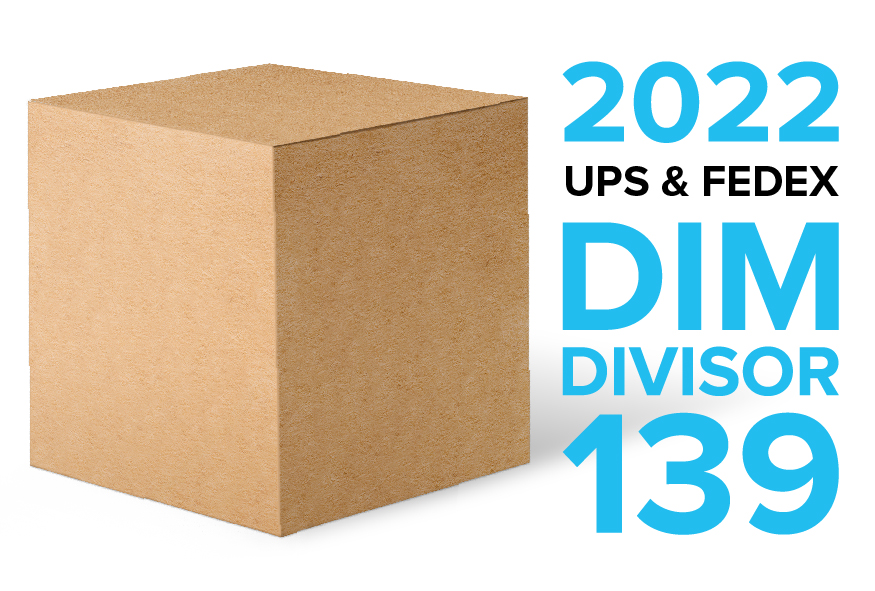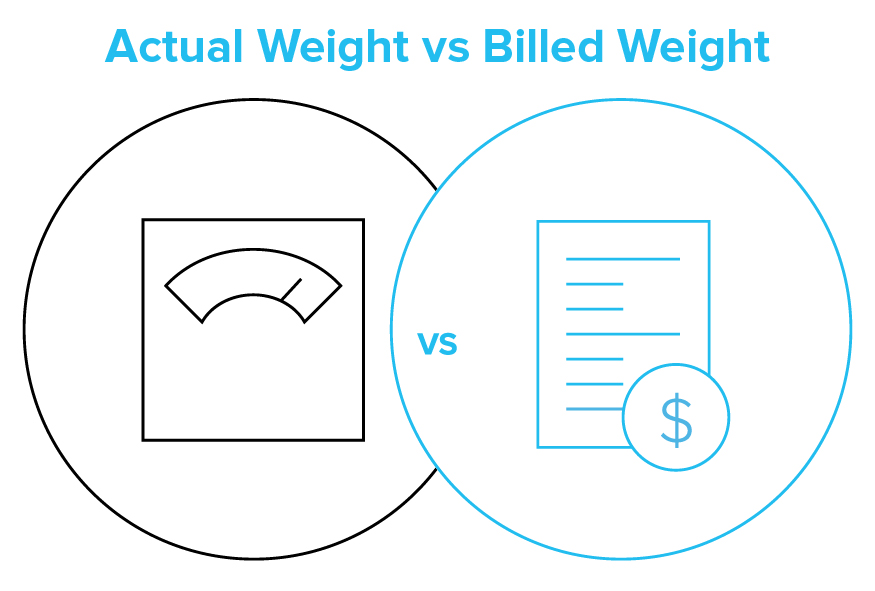Editor's Note: This post has been updated with new links and content.
Original Publication Date: April 1, 2016
Dimensional weight - also known as DIM weight - is an important topic for shippers and anyone involved in the supply chain.
Here's what you can gain from this post:
- Variables in shipping rates
- How weight is calculated (hint: it's more than just how heavy a package is)
- Dimensional weight formula (and calculator)
- Common DIM mistakes
- Free resources to help solve your DIM issues
Unlike the weight of the package that you see on a scale, dimensional weight measures package density and how much space the package will fill. Watch as we dive into some of the DIM details.
Variables in Shipping Rates
Let’s start with how shipping rates are calculated and the variables involved.
The first variable is the service level. That can be ground or a multitude of air services. There's next-day, second-day, and three-day select with some carriers.
Second is the zone, which factors in the origin zip code along and the destination zip code. And finally, you've got the weight. And that can be the actual weight or the dimensional weight of the package.
To summarize, the three shipping rate variables are:
- Service level
- Zone
- Weight
You can quickly evaluate transit time and cost with the Service Level Usage dashboard. Watch this video walk-through or take a self-guided demo here.
How is Weight Calculated?
There are a few different ways that carriers look at weight. Most carriers take the actual or physical weight of the package, which is what we consider billable weight. That’s where the difference between the actual weight and the dimensional weight becomes important.
When you create a free Lojistic account, your Average Actual Weight vs Average Billed Weight is tracked automatically and segmented by air services, ground services and all services combined.

Unlike the actual weight of the package, which is the weight that you would see if you put it on a scale, dimensional weight looks at the package density and how much space the package will take up in the package car. You can use the DIM weight calculator to confirm the DIM weight of your packages.
COST SAVINGS TIP: If there is a big difference between the actual weight and the billed weight of your shipments, the carrier’s dimensional pricing is negatively affecting your shipping costs. You can fix that. (Psssst: It’s easy with Lojistic.)
Dimensional Weight Formula
Dimensional weight is calculated as length x width x height divided by a DIM factor. The published DIM divisor is 139 in 2022 for FedEx and UPS .

So you take the length x the width x the height, divide that by 139 (the published DIM factor) and you'll get a number. The fallout of that is what the carriers consider to be the DIM weight.
In other words, dimensional weight measures the package density, which is the amount of space that the package will occupy. This is important for things like packing package cars, loading airplanes or managing the feeder network.
Why is Dimensional Weight Important?
You might be overpaying by a lot if you aren't paying attention to your DIM weight.
Let’s look at an example. Maybe you want to ship a coffee cup, and you put it in a massive package. The parcel may only weigh two pounds, but it takes up the space of a refrigerator box.
Dimensional weight is the carriers’ way of billing for that extra space, and also incentivizing shippers to use the most efficient packaging possible. It’s important to use the most efficiently sized packaging for the products you’re shipping.
Many businesses have improved significantly over the past two years. As always, the carriers find new and creative ways to maximize profits. As shippers get smarter, so do the carriers. In 2022, UPS and FedEx focused on short-zone, lighter weight packages by rolling out a 6.8% increase for Ground, Zone 2, 1 lb. shipments (increasing to $9.36 from $8.76).
Learn more about rate increases for 2022 with our Annual Carrier General Price Increase Report. View or download your copy here or by clicking the image below.
Common Mistakes Calculating Dimensional Weight
One typical mistake we’ve seen is that UPS and FedEx customers don't know what the DIM factor is. They might think that there's a different DIM factor that they should be using. If you are ever confused about a UPS/FedEx DIM factor - Lojistic can help!
The biggest mistake, however, is usually when a customer looks at the bottom of the box or the carton that they're using and they use the dimensions that are stamped on the bottom of the box to calculate the dimensional weight without measuring the outside of the box. The dimensions on the bottom of a box are actually the internal dimensions so that customers know exactly what fits inside.
If you were to measure the outside of the box, depending on the size or the type of corrugate you're using, those dimensions can be off by a quarter-inch to a half-inch. In short, your box is probably a different size than the dimensions stamped on the bottom.
If you’re looking at a 12 x 12 x 12 box and think that that’s what it will ship at because that's printed on the bottom, that’s usually not the case.
Most likely that box will be 'dimmed out' closer to 13 x 13 x 13 because the carriers are scanning the outside of the box, not the inside.
COST SAVINGS TIP: Measure the outside of the box you’re using. Don’t rely on the measurements printed on the bottom.
Does Dimensional Weight Apply to All Services?
Every service, including the final-mile delivery services that UPS and FedEx offer through SurePost (UPS) and Ground Economy (FedEx - formerly SmartPost), are subject to dimensional weight.
If you’re shipping ground, air, or postal hybrid, dimensional weight will be a factor.
Not sure how DIM weight is affecting your business? Create a free Lojistic account. Don’t be left in the dark with DIM questions.
How Has Dimensional Weight Changed Over the Years?
In recent years the carriers have lowered the DIM factor a few times. A few years ago it was actually 166, and the carriers recently moved it down to 139. Obviously, if you decrease the DIM factor, the dimensional weight will be higher. Dividing by a smaller number gives you a higher dimensional weight for a package with the same billable weight.
Also, dimensional weight didn't always apply to ground shipments. It started with air packages, and ground was not subject to DIM. When the carriers started applying ground dimensional weight in 2015, neither carrier applied it to the postal-hybrid services.
After a while, however, UPS and FedEx both decided that every package shipped through their networks would be subject to DIM. In short, the carriers seem to be looking for additional ways to apply DIM, number one, and then bill it at the highest weight possible. They’re always evolving their methods for maximizing their profits.
The Future of Dimensional Weight
Lots of shippers assume that the carriers will lower the published dimensional factor down again.
It will probably be closer to 100, or “one,” but less than 139. It might not happen in the next couple of years, but at some point, it will probably be reduced at least one more time.
That said, as the DIM factor drops, shippers should remember that everything, including dimensional weight, is negotiable.
The first step is understanding how the current DIM factor affects your overall shipping costs.
If you have questions about DIM factor impact or anything else that might be causing your shipping expenses to be higher than expected, create a free Lojistic account. The Lojistic platform will give you an assessment of your shipping spend and identify areas where you can save.
If you prefer to speak with someone, reach out to Lojistic here and one of our strategy experts will contact you at your convenience.
Negotiating Dimensional Weight
Your ability to negotiate DIM factors will vary depending on how much they impact your package characteristics.
If you aren’t overly impacted by the published DIM factor, for example, then it might not necessarily be too much of an issue. If you are being impacted, however, and the actual weight in your average build weight is off by more than 2-2½ pounds, it would probably be wise to reach out to the carrier and ask them if they can help with your DIM factor.
Minimizing the DIM Impact
Shippers can try other methods to minimize the impact of dimensional weight aside from negotiating a custom DIM factor. One option is to audit the corrugate you're using.
A lot of customers who reuse inbound boxes, for example, think they're saving money. But the dimensions of a reused box are often greater than the billable weight or the actual weight of the package would be. In other words, you’re saving dimes but spending dollars.
The best thing to do is look at your corrugate, and if you have the opportunity to reduce the size of the boxes you're using, do it. In addition to negotiating a better DIM factor, those are the best two ways to start minimizing the impact of a DIM.
Before you try to solve for any of your potential DIM weight issues, you must have an understanding of the severity of your Actual Weight vs Billed Weight problem. Lojistic analyzes that for you. It's free.

If you’re looking for other ways to control and reduce shipping costs for your company, create a free Lojistic account. The Lojistic platform identifies your unique savings opportunities based on your historical shipping data.
